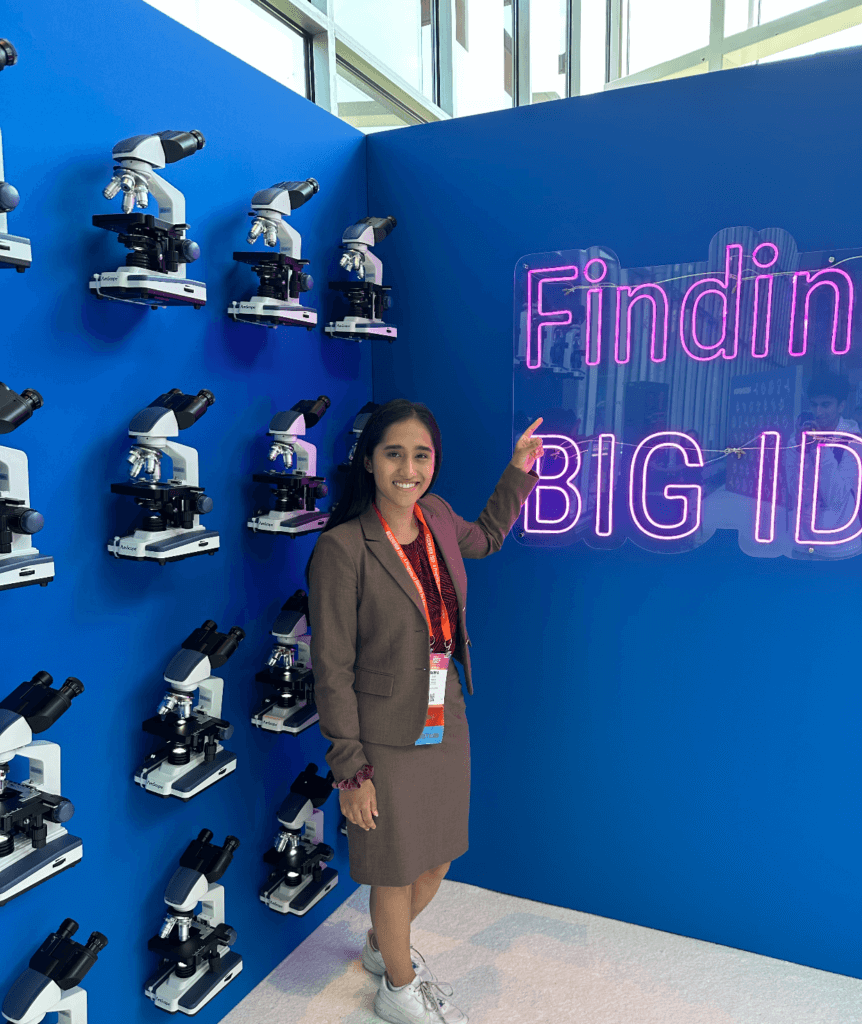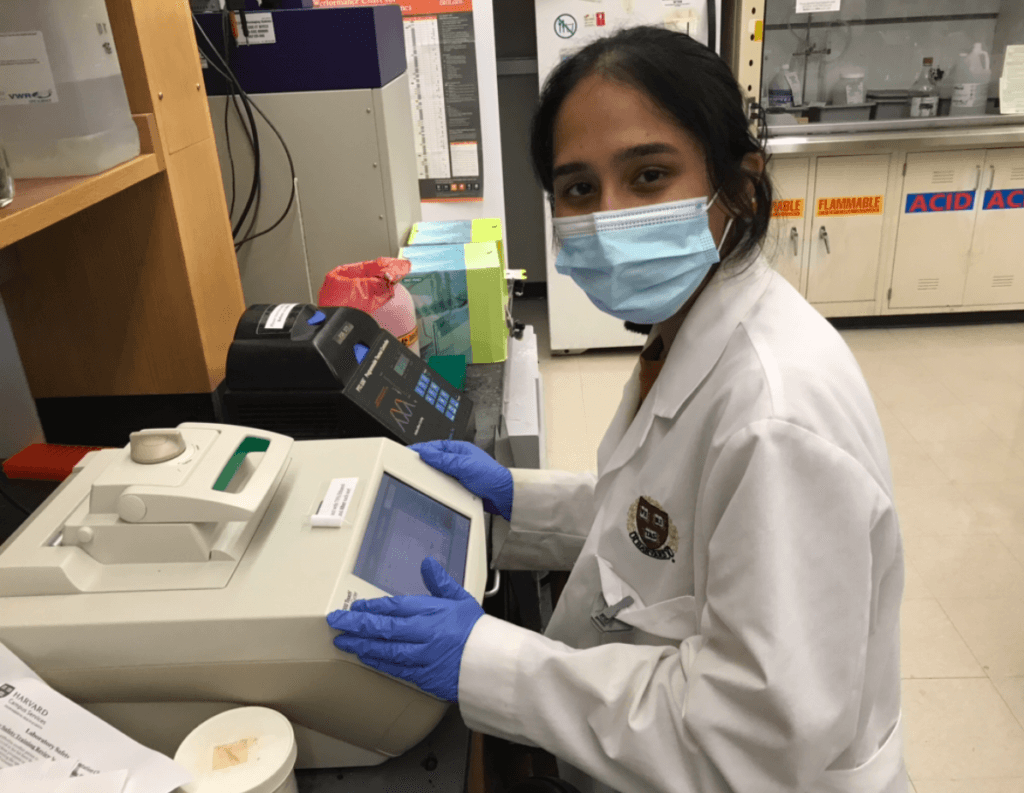Molecular Biologist | App Developer | Champion of Affordable Medicine
In 2020, Mary Kay launched the Young Women in STEM (Science Technology Engineering and Mathematics) grant program and social campaign to help shift the perception of “the face of science,” and encourage young women to pursue STEM paths. Since then, we have awarded nearly 20 grants to young women in STEM all around the world.
Meet 2023 STEM Grant Recipient Shriya Bhat! Shriya is a freshman at Harvard, a molecular biologist, and an app developer, conducting research in gene therapy, CRISPR, and microbial diagnostics. At just 5 years old, Shriya created and conducted her first science experiment – adding acidity to the water of her mother’s tomato plants to help them grow – and it worked! Fast forward 13 years and numerous science projects, Shriya has completed four years of internationally-recognized independent research into inhibiting bacterial cell communication to slow its growth – research inspired by the death of a relative to a bacterial infection. Shriya strongly believes, “Our unique life experiences provide diverse perspectives in how we approach problems and motivate us to continue to tackle challenging questions.”

Describe your STEM projects/interests.
In high school, I conducted four years of independent research to inhibit bacterial cell communication (known as “quorum sensing”) within bacterial biofilm, a highly resistant form of bacterial infection. I developed a combination therapy consisting of natural, phenolic compounds that inhibited cell communication within the biofilm. This research was inspired by the passing of a close relative to a bacterial infection associated with her cystic fibrosis, and this research placed first at the International Science and Engineering Fair (ISEF) in both 2022 and 2023. I continued my research on antibiotic resistance during the summer of 2022, when I worked under Dr. Lory at Harvard Medical School to clone an antibiotic resistance gene in Pseudomonas aeruginosa bacteria. We hoped to find allosteric binding sites on an antibiotic resistance enzyme to develop better drugs to combat Pseudomonas bacterial infections. This past summer, I interned at Regeneron Pharmaceuticals, developing a stronger interest in transcriptomics-based research to optimize current immunotherapies. Additionally, I am also currently working at the Church Lab on viral delivery for gene therapy in hope of treating genetic diseases like cystic fibrosis. Some of my other projects was that I worked with professors at the University of Texas at Dallas to develop an app called MoleculeGo, the educational biology version of the popular gaming app PokemonGo that aims to help students learn more about molecular biology.
What/Who inspired you to get into STEM?
In kindergarten, I often watched my mom water our tomato plants in our backyard garden. I was pretty impatient back then (there’s not much to do at age 5) and I wanted the plants to grow faster. Remembering my teacher telling me that certain plants grow better at a lower pH, I wondered if slightly more acidic water would enhance the growth of our tomatoes. So, my mom helped me add a little vinegar to the water, experimenting on only half the plants, and it worked! A few weeks later, we were greeted with larger, redder tomatoes. I excitedly told my teacher about this project, and she encouraged me to present my research at our elementary school science fair.
Since then, every year I competed in my school’s science fair, with my projects growing in complexity. I developed a deep interest in biology both in and out of the classroom; I absorbed information from my teacher’s instruction and began reading Scientific American and Nature news articles, developing a deeper interest in our world’s diverse microbiome. In seventh grade, I experimented on how different organic fertilizers impact the plant’s rhizo-microbiome; in eighth, I developed interests in clinical microbiology, experimenting on whether immunosuppressive steroid nasal spray facilitating the growth of deadly MRSA bacteria in the nose. This lead all the way up to my high school research on Pseudomonas antibiotic resistance, and all of these experiences have encouraged me to pursue a career in research. My teachers and mother had a huge impact in encouraging me to pursue STEM throughout middle and high school, and I owe much of my success in STEM to the incredible support I received from my peers, mentors, and education system in Plano, TX.
What are some advantages you think being a female brings to the STEM field?
Being female in STEM makes us stronger, more resilient, and more determined to succeed. Our unique life experiences provide diverse perspectives in how we approach problems and motivate us to continue to tackle challenging questions. Also – our strong communication and collaboration skills are beneficial in STEM fields where teamwork and effective communication are crucial for success. Ultimately, being female should not be seen as a limitation, but rather a strength that allows us to bring new ideas, solutions, and perspectives to the table.
What would you tell young girls who are interested in STEM, but too intimidated or discouraged to pursue it?
Remember that no one starts off as an expert! It will take time and effort to develop your skills, but every step you take towards your passion will only make you stronger. The historic stigma that women are incapable of pursuing STEM is a complete fallacy, generated by society to keep us in traditional roles where we were historically more valued. Don’t let this discourage you – you have just as much potential to succeed in this field as anyone else. Never be afraid to ask for help or guidance and surround yourself with positive influences who believe in your abilities. You can do this.

What do you think is most exciting about the future of STEM, and is there a specific advancement you’d like to see happen?
I think the development of gene editing technologies like CRISPR systems and prime editing is incredibly exciting. These advancements have the potential to revolutionize medicine and agriculture by targeting and correcting specific genetic mutations. Specifically, I am interested in using these tools to better understand cell-specific biological pathways in cancer cells as well as better understand the transcriptomic profile of bacterial cell population in the presence of antibiotics.
Who’s your favorite female icon and why?
Gerty Cori is one of the most influential female medical scientists of her time. In 1947, Cori won the Nobel Prize in Physiology for her work in medicine, becoming the first woman to do so. Her work led to the discovery that enzyme deficiency could be responsible for metabolic disorders. She also carried out multiple studies on the action of pituitary hormones and uncovered the process of cellular energy storage and release, answering one of the most fundamental questions about the human body. What I find most admirable about Gerty Cori is her unrelenting determination and perseverance in pursuing her passion for scientific discovery, despite facing numerous obstacles as a woman in the male-dominated field of science during her time. She received her medical degree in a time when it was not common for women to pursue higher education, and she faced discrimination and skepticism from her male colleagues. Gerty Cori’s groundbreaking work in biochemistry has had a lasting impact on the understanding and treatment of diseases, and her legacy continues to inspire and empower women in the field of medicine and science.